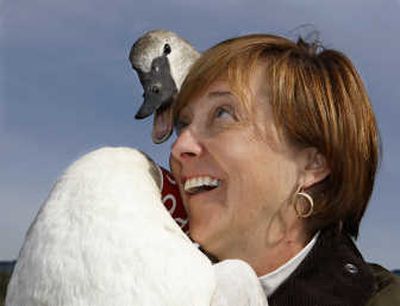Trumpeter swans set free

OVANDO, Mont. – Ten more trumpeter swans were released this week near Ovando in an effort to re-establish a migrating population in the Blackfoot River Valley.
“We’re right at the cusp of this program taking off,” said Bill Long, of the Wyoming Wetlands Society.
Thirty more trumpeters will be set free in June, joining 40 others that have been released over the past three years.
“You felt just an armful of life,” said Kat Imhoff, state director of the Nature Conservancy, and one of six people who held the 1-year-old birds Monday before setting them free on a small lake on the Two Creek-Monture cattle ranch. Four trumpeters had been released on Sunday.
The birds’ wing feathers were clipped to prevent them from flying away for the next two months. They were released in May instead of June as in previous years in an effort to attract other swans returning from winter migrations, said Greg Neudecker with the U.S. Fish and Wildlife Service.
Trumpeters return to the areas where they learn to fly, he said.
The goal of the project is to establish at least seven breeding pairs that migrate between Montana and warmer climates, Neudecker said.
He said it could take five to 10 years to establish a breeding population. Swans typically mate when they are 4 to 5 years old.
USFWS is working with the state Department of Fish, Wildlife and Parks, the Nature Conservancy and the Blackfoot Challenge, a coalition of public and private groups that conserve land in the area.
“We wouldn’t be here if it wasn’t for private landowners,” Neudecker said.
The trumpeter swan is the largest native waterfowl in North America. The effort to re-establish the bird in the Blackfoot Valley was made possible by a three-year agreement with Canada, allowing up to 180 eggs to be taken from Canada to raise birds for release in Montana, Wyoming and Idaho.
The Canadian trumpeter eggs are incubated and hatched at the Wyoming Wetlands Society in Jackson.